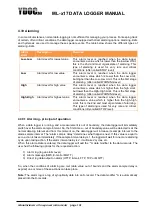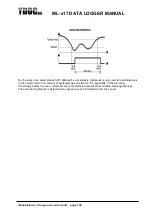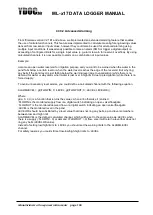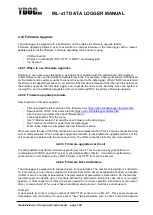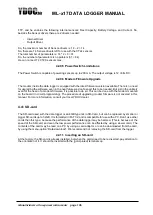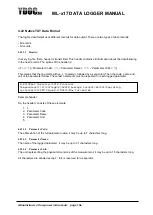
ML-x17 DATA LOGGER MANUAL
Manufacturers of low power instruments
page 98
on the leads. Since the input acts like a differential amplifier, the noise on the negative input is subtracted
from the noise on the positive input. What is left is the sensor-signal.
4.36.3 Using Load Cells
The ML-x17 when equipped with differential inputs is very suitable for connecting load cells and other
resistive elements. A load cell acts as a bridge of Wheatstone and is a very sensitive and precise passive
component.
4.36.4 Bridge of Wheatstone
The bridge of Wheatstone (the principle of operation of a load cell) is a circuit, consisting of 4 resistors.
Below a circuit is given:
4.37 Potentiometer input
The ML-x17AD or ML-x17ADS is equipped with a potentiometer input. This input is a 0..3300mV voltage
input. It is designed especially for potentiometers, like the ones in winddirection meters and angle meters.
This input is connected to the internal ADC directely and is translated into a 0 % - 100% value. The user
has to connect the potentiometer between the 3.30V Vref and ground. The ML-x17 has a Vref output for
that. (Terminal X1.8). Because of the fact of the potentiometer is connected between Vref an ground, the
ADC value will always be the full range (0..4095) INDEPENDENT of the value of the connected
potentiometer. So, all types and all values of potentiometers are supported.
Although all values are supported,we strongly recommend to use high values only. This is because the
lower values are draining more power from the data logger. Values between 100K and 4M7 are
recommended.
A potentiometer gives a value what is translated to 0.. 100%, and can be re-scaled to engineering values
by the user. A potentiometer is a variable resistor with three terminals. (see picture below)
Figure 2: Potentiometer
The two outer terminals are connected to the fixed resistor and the middle terminal is connected to a
slider. So, when a potentiometer is turned, the resistance between the middle terminal and one of the


















